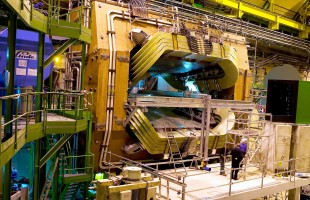The LHCb experiment at CERN has revealed a fundamental asymmetry in the behaviour of particles called baryons.
Yesterday, at the annual Rencontres de Moriond conference taking place in La Thuile, Italy, the LHCb collaboration at CERN reported a new milestone in our understanding of the subtle yet profound differences between matter and antimatter. In its analysis of large quantities of data produced by the Large Hadron Collider (LHC), the international team found overwhelming evidence that particles known as baryons, such as the protons and neutrons that make up atomic nuclei, are subject to a mirror-like asymmetry in nature’s fundamental laws that causes matter and antimatter to behave differently. The discovery provides new ways to address why the elementary particles that make up matter fall into the neat patterns described by the Standard Model of particle physics, and to explore why matter apparently prevailed over antimatter after the Big Bang.
First observed in the 1960s among a class of particles called mesons, which are made up of a quark-antiquark pair, the violation of “charge-parity (CP)” symmetry has been the subject of intense study at both fixed-target and collider experiments. While it was expected that the other main class of known particles – baryons, which are made up of three quarks – would also be subject to this phenomenon, experiments such as LHCb had only seen hints of CP violation in baryons until now.
“The reason why it took longer to observe CP violation in baryons than in mesons is down to the size of the effect and the available data,” explains LHCb spokesperson Vincenzo Vagnoni. “We needed a machine like the LHC capable of producing a large enough number of beauty baryons and their antimatter counterparts, and we needed an experiment at that machine capable of pinpointing their decay products. It took over 80,000 baryon decays for us to see matter–antimatter asymmetry with this class of particles for the first time.”
Mara Senghi Soares, programme leader of the LHCb group at Nikhef says “It is a moment of great joy every time nature reveals itself to us a bit more. We were eagerly awaiting to observe and measure this CP violation among baryons for a long time. The most exciting thing is that the LHCb experiment has taken a lot of new data last year, and we are now starting to analyse them. We feel like children opening a “surprise gift box” – what will the new data reveal next? CP violation in baryons is an example of the type of nice things we can learn!”
Read the entire press release on the CERN website: https://home.cern/news/press-release/physics/new-piece-matter-antimatter-puzzle
The article can be found on Arxiv: https://arxiv.org/abs/2503.16954
Nikhef is a member of the LHCb experiment, one of the detectors at CERN’s Large Hadron Collider (LHC) in Geneva. Here, together with international colleagues, Nikhef studies, among other things, matter-antimatter differences.

